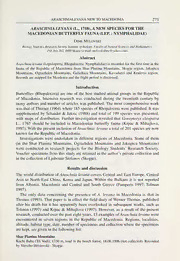
Araschnia levana (L., 1758), a new species for the Macedonian butterfly fauna (Lep.: Nymphalidae) PDF
Preview Araschnia levana (L., 1758), a new species for the Macedonian butterfly fauna (Lep.: Nymphalidae)
ARASCHNIALEVANANEWTOMACEDONIA 273 ARASCHNIALEVANA (L., 1758),ANEWSPECIES FORTHE MACEDONIAN BUTTERFLYFAUNA(LEP. NYMPHALIDAE) : DimeMelovski BiologyStudent'sResearchSociety,InstituteofBiology,FacultyofNaturalSciencesandMathematics, P.O.box162, 1000Skopje(e-mail:[email protected]) Abstract Araschnialevana(Lepidoptera: Rhopalocera: Nymphalidae)isrecordedforthefirsttimeinthe fauna of the Republic of Macedonia from Shar Planina Mountains, Skopje region, Jakupica Mountains, Ograzhden Mountains, Galichica Mountains, Kavadarci and Kratovo region. RecordsaremappedforMcedoniaandtheflightperiodisdiscussed. Introduction Butterflies (Rhopalocera) are one of the best studied animal groups in the Republic of Macedonia. Intensive research was conducted during the twentieth century by many authors and number of articles was published. The most comprehensive work was that ofThurner (1964) where 185 species ofRhopalocera were published. It was supplemented by Schaider & Jaksic (1988) and total of 199 species was presented, with maps of distribution. Further investigation revealed that Gonepteryx cleopatm L., 1767 should be included in Macedonian butterfly fauna (Krpac & Mihajlova, 1997). Withthepresentinclusion ofAraschnia levana atotal of201 species arenow known fortheRepublic ofMacedonia. Investigations were undertaken in different regions of Macedonia. Some of them (in the Shar Planina Mountains, Ograzhden Mountains and Jakupica Mountains) were conducted as research projects for the Biology Students' Research Society. Voucher specimens from this study are retained in the author's private collection and in thecollection ofLjubomirStefanov (Skopje). Resultsand discussion The world distribution ofAraschnia levana covers Central and East Europe, Central Asia to North-East China, Korea and Japan. Within the Balkans it is not reported from Albania, Macedonia and Central and South Greece (Pamperis 1997; Tolman 1997). The only data concerning the presence of A. levana in Macedonia is that in Thomas (1993). That paper is in effect the field diary ofWerner Thomas, published after his death but it has apparently been overlooked in subsequent works, such as Tolman (1997) and Krpac & Mihajlova (1997). However, as a result of the present research, conducted overthe pasteightyears, 13 examples ofAraschnia levana were encountered in seven regions in the Republic of Macedonia. Regions, localities, altitude, habitattype, date, numberofspecimens and collection where the specimens arekept, aregiveninthefollowinglist: SharPlaninaMountains Kuchi Baba (Tri Vodi), 1330 m, road in the beech forest, 18.06.1996 (not collected). Recorded bySlavchoHristovski- Skopje. 274 ENTOMOLOGIST'SRECORD,VOL. 116 25.xi.2004 Skopjeregion Katlanovo (Laka), 400 m, 01.08.1999, along River Pchinja, riparian habitat: 1 ex. (not collected). RecordedbyMetodijaVelevski- Skopje. JakupicaMountains Above V. Nezhilovo, 800-900 m, road in oak forest, 17,18,19.07.1999: 4 ex. (coll. D. Melovski). Kavadarciregion Moglishte,Vatasha,500m,08.04.2001: 2ex. (coll.Lj. Stefanov). RKPUBIJCOF MACEDONIA s1:RBIAANDMONr \ (. UTM • --DM VI • 52 • oa o • ca D EL i;re Fig. L Distribution ofAraschnia levana inMacedonia • New data O DatapublishedbyThomas (1993) OgrazhdenMountains E1zkhmovWoBorfdSou,vi11L5a0kim,,9n5e0arm,monuenatramionusnttraeianm,st1r5e.a0m7,.21070.00:7.120e0x.0:(c1olelx..D(.coMlel.loDv.skMie)l;ovski). Kratovoregion V. Kuklica,nearKrivaRekariver,650m, willowbelt,23.06.2004: 2ex. (coll.Lj.Melovski). GalichicaMountains V. Elshani, fields with hedgerows oiJuglans regia, on flowerofSambucusebulus, 23.07.2004: 1 ex. (photographedbyLj. Stefanov). ARASCHNIALEVANANEWTOMACEDONIA 275 The distribution of Araschnia levana in Macedonia is presented on Fig. 1. Specimens from The Shar Planina, Jakupica, Ograzhden and Galichica Mountains and the Skopje and Kratovo regions were summerforms, collected from late June to the end of July. The only spring forms were recorded in the Kavadarci region, recordedinApril. The habitats from which the adult Araschnia levana were recorded were beech forests on Shar Planina Mountains, oak forests on Jakupica Mountains and riparian habitats along the Rivers Pchinja and Kriva Reka and near a mountain stream on Ograzhden Mountain. The record on Galichica Mountain refers to agricultural land, butthis is situatedin the oakbeltofthemountain. Acknowledgements I would like to thank Dr. S. Abadjiev (Sofia, Bulgaria) for his valuable help and Slavcho Hristovski forhis guidanceduringpreparation ofthispaper. References Abadjiev, S., 1995. Butterflies ofBulgaria Vol. 3, Nymphalidae: Apaturinae & Nymphalinae. Sofia. Krpac, V. T. & Mihajlova, B., 1997. Gonepteryxcleopatra (Linnaeus 1767), anew species ofthe butterflyfaunainMacedonia(Lepidoptera: Pieridae).ActaEntomologicaSlovenica5: 113-116. Pamperis,L. N., 1997. ThebutterfliesofGreece.Bastas-Plessas. Schaider,P. andJaksic,P., 1988.Die TagfaltervonjugoslawischMazedonien. Schaider. Thomas, K., 1993. Die entomologischen Reisen von Werner Thomas. Nachr Entomol. Ver 13: 405-446. Thurner, J., 1964. Die Lepidopterenfauna von jugoslawisch Mazedoniens. 1. Rhopalocera, GrypoceraundNoctuidae.NaturalHistoryMuseumSkopje 1: 1-158. Tolman,T., 1997.ButterfliesofBritainandEurope. HarperCollins. Square-spotted Clay Xestia rhomboidea (Esp.) (Lep.: Noctuidae) in Essex, first discovery ofthe caterpillarinthecounty On 15 March 2004, a caterpillar ofthe Square-spotted Clay Xestia rhomboidea was found at Free Wood, Elmdon, in Essex, the first ever found in the county, providing proofthat the moth is resident in Essex. It was found by Robin Field at 20.47 hours, at resthead downwards on adead stem ofCommon Nettle Urtica dioica above fresh nettle foliage at the end of a search by nine of us from 20.20 to 20.50 hours. The larva was in an area of fairly sparse ground vegetation just inside the edge of the wood. The accompanying photograph, taken at the time, shows the habitat at the exact spot. Colin Plant (centre) is pointing at the larva with his torch. It is between him and the bag on the ground. There are shrubs within three metres, but the larva is in amoreopen situation andthere are scattered grass tussocks forshelter. It is instructive to examine how this result is the culmination of the combined efforts ofvarious members ofthe mothing community, coupled with an increasingly
